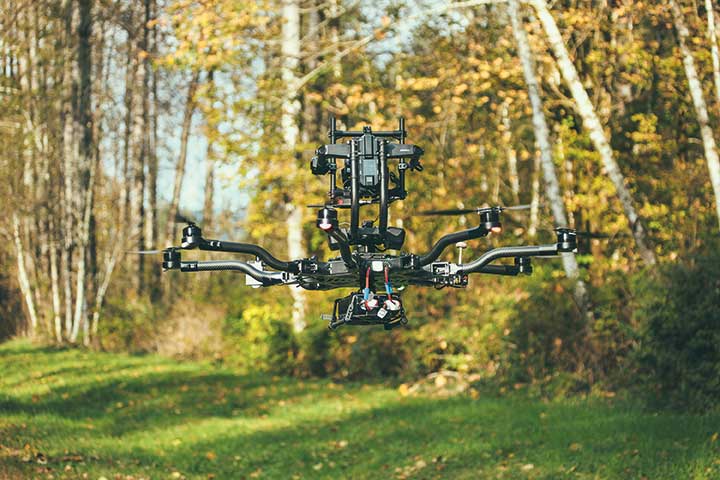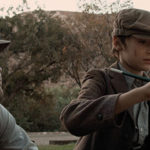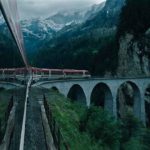
Doctor Drone
Posted on Mar 23, 2017 by Julian Mitchell
 Ben with his Alta, MoVI and the SONY A7S MkII.
Ben with his Alta, MoVI and the SONY A7S MkII.
It isn’t just Ben Kenobi’s name that is surprising but also his rise to his current drone operator status from where he started – the NHS. JULIAN MITCHELL reports.
About three years ago a clash of industries turned into the drone business that is still changeable today. The RC crowd saw an opportunity to earn money from their hobby while the broadcast and film cinematographers and videographers saw a drone as an essential addition to their kit bag. This coming together has resulted in a melting pot of drone companies and also skill levels.
We don’t usually profile drone operators but have done for companies who run helicopters, drones and gyros. But Ben’s rise to fame feels like a tale that is typical of this mishmash of operators and the land-grab feeling typical of a nascent industry.
Just over three years ago Ben was a radiographer working for the NHS in London. He was also a keen RC hobbyist but a reluctant medical man and he soon persuaded his wife to make the London exit to the countryside like thousands of others had done before him.
The only difference was that Ben didn’t have a radiography job to go to – or any job for that matter. But it is a measure of the man that he put down roots in the Cotswolds very near to a drone training centre where he signed up the same day he walked in to his new house.
“I built a radio-controlled helicopter in my spare time while I was in London and got quite proficient with it, doing acrobatics to quite a high level,” he says. “Acrobatics on a helicopter are quite difficult so I found flying drones quite easy. DJI then brought out some reliable drones, one of which I bought for £8000. My wife agreed to me having the drone as long as I built a business around it.”
From Radiation to the Cotswolds
Ben had talked about his new drone on an Internet forum and soon got a call about a job filming a man cycling down a runway. His eyes were suddenly opened to this new way of working. “I looked at all the film crew and couldn’t believe that this was their job; why was I in a dark room being blasted with radiation and with people throwing up on me?”
By his own admission Ben learnt everything about flying drones from the Internet, he didn’t have RC friends and wasn’t part of any club scene. The camera he had chosen for his drone was a hacked Panasonic GH2 which gave him a pimped data rate of over 100Mb/s. Little did he know at the time that the combination of DJI’s first brushless gimbal and the GH2 provided some of the best stabilised video around. He only realised it when he mixed with other dronies at the same level.
“I looked at all the film crew and couldn’t believe that this was their job; why was I in a dark room being blasted with radiation and with people throwing up on me?”
Ben had practised flying his drone around stately homes in his immediate area and a comment from his Mum sparked interest from a local DJ who welcomed phone calls from listeners to suggest places where Ben could fly his drone. This was when drones interested local people and didn’t annoy them like they do now.
After making videos of his practise tests around the places that were suggested he started getting phone calls from TV producers and his first TV job for BBC West. Soon The History Channel came calling for him and Ben’s drone became the first to fly over Stonehenge.
“The Stonehenge footage just came out perfectly; it was a beautiful morning with the remains of mist on the ground. Even though it was my old GH2 with interlaced footage.” After that footage got online a whole lot of production companies started to get in contact.

Heavy Lift
Ben’s story has since then taken on a direction that most ‘dronies’ won’t have aspired to. He quickly saw that the majority of drone work was going to be for the broadcast industry and so invested in an aircraft and gimbals from Freefly Systems, the company who started the handheld gimbal craze off with its MōVI.
But he also invested in a training and licensing academy that services all those who want to earn themselves a licence. “We have many cameramen coming into the academy to train up.”
The heavy lift camera work has really taken off in the last 18 months; Ben was hesitant to start with just because of the amount you have to invest. But the price got cheaper and he invested. “You get shorter flight times and slower speeds and I use cameras like the ALEXA Mini and RED cameras. Cameras like the Sony A7s cut really well with those cameras too and also give me 27 minutes of flying time.”
There are only around 300 companies with a heavy lift licence in the country so Ben has an instant advantage over the Phantom brigade who may pitch for the same work. But 99% of Ben’s work is broadcast and his DJI Inspire covers that market happily.
O Lucky Man
It is easy to see that Ben’s rise to international drone operator is one of being in the right place at the right time, but I think that ignores the incredibly hard work he has had to put in to make a success of a business that is changing rapidly. There is now talk of mergers and associations with companies like Flying Pictures acquiring other drone firms.
“There’s a company called AirStock who were a footage company and now they are taking on lots of qualified pilots to form an agency. I can see them pulling it off, the only problem is you may lose your identity when you work for a company like that even though you are freelance.”









